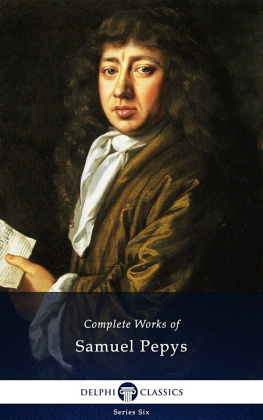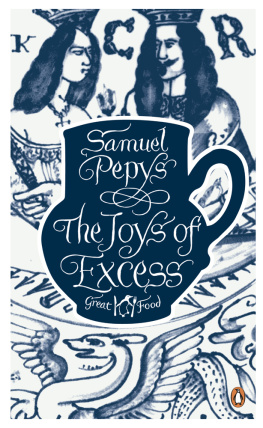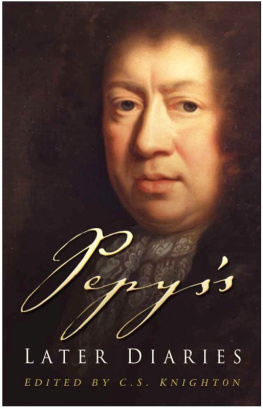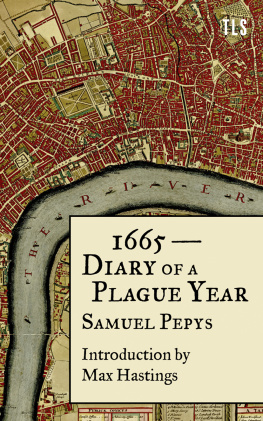The Complete Works of
SAMUEL PEPYS
(1633-1703)

Contents

Delphi Classics 2015
Version 1

The Complete Works of
SAMUEL PEPYS

By Delphi Classics, 2015
COPYRIGHT
Complete Works of Samuel Pepys
First published in the United Kingdom in 2015 by Delphi Classics.
Delphi Classics, 2015.
All rights reserved. No part of this publication may be reproduced, stored in a retrieval system, or transmitted, in any form or by any means, without the prior permission in writing of the publisher, nor be otherwise circulated in any form other than that in which it is published.
Delphi Classics
is an imprint of
Delphi Publishing Ltd
Hastings, East Sussex
United Kingdom
Contact: sales@delphiclassics.com
www.delphiclassics.com
The Diary

Samuel Pepys was born in Salisbury Court, Fleet Street, London on 23 February 1633. He was the son of John Pepys, a tailor, and Margaret Pepys (ne Kite), daughter of a Whitechapel butcher.

A plaque commemorating the site of the birthplace

Hollars 1666 map of London before the Fire

117 Fleet Street one of the few surviving buildings that Pepys would have known. The first floor now contains a museum dedicated to the diarist.

Fleet Street today

Pepys was baptised at St. Brides Church on 3 March 1633.

Portrait of Samuel Pepys by J. Hayls, 1666
BRIEF INTRODUCTION OF THE DIARY

Samuel Pepys (1633-1703) lived through some of the most dramatic events in English history. Raised in a Cambridgeshire family of minor landed gentry with Parliamentarian sympathies, as a boy he attended the same grammar school as Oliver Cromwell in Huntingdon and saw and welcomed the execution of Charles I although he was later to become an Anglican and was even denounced as a papist by political opponents during a parliamentary election in the 1670s. He of course witnessed the Restoration of the monarchy in 1660 and as a Londoner he experienced the Great Fire and the Plague of London and was able to enjoy the many privileges that the London of the times had to offer to an affluent resident. Pepys loved dinner parties and social gatherings and much has been made of his love of female company, although a feminist reading of his diaries suggests that he imposed his attentions on more women (especially those of lower rank) than received invitations from them.
As an enthusiastic book collector, Pepys frequently browsed the London bookshops and had a fine library of his own, which by his death in 1703 comprised some 3,000 volumes and which now resides Magdalene College, University of Cambridge, from which he graduated in 1654. Many of the volumes still retain the bindings he commissioned and the library includes an eclectic mix, including medieval works. It is also the home of the original six bound volumes of his diaries and the whole is still housed in the glass fronted cases Pepys had made to house his beloved collection. The fact that Pepys had his writings bound to become a part of his library suggests that he considered them to be of some worth or at the very least, of sentimental value.
Apart from his personal diaries and his full and active social life, Pepys forged a career as a diligent and effective civil servant and had an equally diligent if somewhat less illustrious career as a Member of Parliament. His first position as a civil servant was as secretary to a relative, Edward Montagu, and he moved from there to the Exchequer; it was at about this time that he acquired a house in Axe Yard, where he settled with his wife Elizabeth and was to write his diary. In 1660 Pepys recorded in vivid detail the coronation of Charles II and this was also the year he was appointed as Clerk of the Acts to the Navy Board and was to prove invaluable as one of the driving forces towards reform of the navy. Many readers are surprised to find how young Pepys was when he started and finished his diary twenty-seven years of age at the start and only thirty-six when he stopped as a result of his fears that his eyesight was failing.
It is difficult to say definitively why Pepys wrote his diary. It is taken now as fact that he never wished to share his thoughts with anyone else, as the diary was written in a shorthand used at the time; perhaps as a keen bibliophile he wanted to write his own works, but was not drawn to literary genres such as poetry, and in his position as a civil servant, political tracts may have been unwise. Possibly, he was testing his memory for everyday minutiae, as the joy of the diaries is the detailed picture they paint of life in the nations capital during these ten years. Another theory is that he wrote the diary out of sheer vanity, to record and to be able to relive the events in which he was a key player. Whatever the reason, he writes with humour, a sharpness of wit and a down to earth honesty not only about himself, but about others too. Perhaps he wrote them to record the successes of his life and work, as he was an extremely capable civil servant, more so than a number of his aristocratic betters. No detail of his life was deemed unworthy, or so it would seem the reader can live each day with him from waking up, through his dinners, conversations, assignations, work and interactions with nobility, merchants, lovers and servants alike, and it is as if we are at his shoulder through every moment. It is little wonder that Pepys is regarded almost as a living friend by his many admirers.
Pepys lived another thirty-four years after he ceased writing his diary, and during this time he was a Member of Parliament for Castle Rising, Norfolk, from 1673-9 and for Harwich in 1679 and 1685-7, thus serving as an MP in the reigns of both Charles II and James II. During his post-diary career, he was accused of two misdemeanours, serious enough to see him detained; firstly espionage in 1675 and in 1690 of being a Jacobite. On both occasions he was released; he was a loyal Englishman and if he had Jacobite sympathies, he did not act upon them. In 1684 he was president of the Royal Society, but it was his book collection that occupied his leisure time after he ceased writing the diary. After a few years of ill health and decline, Pepys died in 1703 and was buried in St Olaves Church in London.
Next page


















